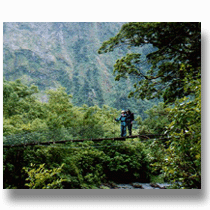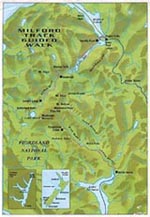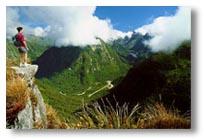|
1. Crossing the Mackinnon Pass in the Early Autumn Rain
In the midst of the nature, carrying a heavy backpack and looking at the surrounding scenery and living creatures, you walk leisurely for many days. At dusk, you can put down your bag in a clean mountain hut, take a hot shower, have a warm meal and sleep in a big, comfortable bed. In New Zealand, there are many such walks or hiking courses.

Milford Walk
Copyright1998 Shiro Watanabe |
In the 19th century, the Scottish immigrants gave their names to the untouched mountains, lakes and rivers. They cleared the fields to build promenades wherever they wanted, as if they were constructing expressways, and built mountain huts. Reaching the mountaintop was not their goal, but rather to absorb nature and enjoy walking in and of itself. Therefore, the trails are very easy to walk. There are many different courses, from ones that start from the lakes, go along glaciers and out to the sea, to ones in which you canoe around the island.
If you are expecting a mountain climb in the true sense, you might be disappointed.
As for myself, walks with a comfortable bed, meals and guide, and which take you deep into nature over several days, create a luxurious, healing trip that would be difficult to find in Japan.

Click here to enlarge
(large volume of data) |
The four-day, three-night, 55-km Milford Track in Fiordland National Park, a World Heritage Site, is known as "the finest walk in the world." It was also selected as one of the Nine Best Classic Walks of New Zealand.
It was the first walk in the world-dating back a hundred years-to have package tours with meals, lodging facilities and guides. But nowadays, the advance of environmental destruction is taking a toll. This may due to too many visitors who came here for the beautiful nature and excellent facilities.

Peak, Mackinnon Pass
Copyright1998 Shiro Watanabe |
The last time I was here was at the end of March, in early Autumn, four years ago. The flowers were withered and looked like dried flowers. The day we crossed Mackinnon Pass (1154 m), the highlight of the trip, there was a bad storm with heavy wind and rain. I couldn't stand on the Peak, couldn't see an inch in front of my face, and the insides of my shoes were completely soaked. The cold was such that I thought I was freezing. On the way down, I felt as if my body was driftwood being carried away in a mountain torrent.

Sutherland Falls |
Heavy rain caused numerous waterfalls and rivers all over the mountain, but the ferns, moss, rocks and beech forests looked vivid. It was as if nature were playing a grand symphony all at once. At the Sutherland Falls, which has a drop of 500 meters, innumerable falls were cascading down from the cliffs everywhere. It was the climax of the symphony.
The previous day, I had fallen. Hiding the top of my left hand, which was unsightly swollen, I withstood high fever and severe pain and walked through the heavy rain, carrying my pack. A New Zealand surgeon who was among the hikers treated it for me. When I was told the bone was broken, I was astonished. Everyone praised me as the "bravest walker", but I had simply been unaware of it.
Copyright1998 Setsuko Watanabe
|



